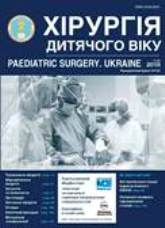Two-stage osteosynthesis of bilateral multiple multifragmental fractured ribs in patients with severe respiratory failure
DOI:
https://doi.org/10.15574/PS.2018.60.34Keywords:
multiple multifragmentary fractured ribs, two-stage osteosynthesis, respiratory failureAbstract
Patients with bilateral multiple multifragmental fractured ribs with the formation of flotating chest wall accounted for 0.4% of all patients with thoracic injury being treated.
Objective: to evaluate the efficiency of the step-wise metallic osteosynthesis in bilateral multiple multifragmental rib fractures.
Materials and methods. A retrospective analysis of the treatment of six patients was carried out. For the stabilization of the chest were carried out two-stage osteosynthesis of the ribs, pneumatic stabilization and traction of the flotating flap. Osteosynthesis of the ribs was conducted by using Ilizarov's needles in two stages to reduce surgical injury and stabilization of the patient between the staged surgical interventions.
Results. In patients who underwent osteosynthesis of the ribs, there was a decrease in the artificial lung ventilation duration (6.75±3.4 days) and the stay time in the intensive care unit (12.0±2.4 days) observed as compared to the unoperated patients. Also in the group of operated patients, it was observed a quantity reduction of respiratory complications, length of hospital stay and mortality.
Conclusions. Carrying out the two-stage osteosynthesis of the ribs in patients with a flotating chest wall allows reducing the surgical injury and operation length and achieving stabilization of the thoracic framework, reducing mortality, shortening the terms of artificial ventilation, staying in the intensive care unit, the length of hospital stay and the number of respiratory complications. Conservative methods of chest wall stabilization can be used to prepare the patient for surgical treatment.
References
Benyan AS. (2017). Blunt chest trauma: possibilities to stabilize multiple and floating ribs fractures. Hirurgia. 8; 69–74. https://doi.org/10.17116/hirurgia2017869-74
Getman VG. (1998). Surgical treatment of chest wall injuries and of their sequelae. Kiev: 32.
Davydova NS, Shen´ NP, Skorokhodova LA, Boltaeva PG, Lukin SYu, Besedina EA, Nikol´sky AV. (2017). Clinical and economic significance of respiratory biomechanics advanced control when performing prolonged artificial pulmonary ventilation in patient with severe blunt chest trauma after metal structures interstitial rib stabilization. Anesteziologiya i reanimatologiya. 6: 412–418.
Korymasov EA, Benyan AS. Pushkin SYu. (2016). Philosophy of surgery of the multiple and floating fractures of ribs. Vestnik khirurgii imeni II Grekova: 175 (3); 106-110.
Magomedov AYu, Vinokurov SA, Nepomnyashchy VG, Magomedov YuA, Vladzimirsky AV. (2010). Diagnostics and treatment of the combined injuries of a thorax and extremities. 11(3). http://www.mif-ua.com/archive/article/19991
Pronskikh AlA, Kravtsov SA, Pronskikh AA. (2014). Surgical restoration of chest structure in a patient with polytrauma. A case report. Polytrauma. 2: 65–70.
Granetrny A, El-Aal MA, Emam E et al. (2006). Surgical versus conservative treatment of flail chest. Evaluation of the pulmonary status. Int Cardiovasc Thorac Surg. 4: 583–587. https://doi.org/10.1510/icvts.2005.111807; PMid:17670487
Tanaka H, Yukioka T, Yamaguti Y et al. (2002). Surgical stabilization of internal pneumatic stabilization? A prospective randomized study of management of severe flail chest patients. J. Trauma. 52: 727-732. https://doi.org/10.1097/00005373-200204000-00020; PMid:11956391
Downloads
Issue
Section
License
The policy of the Journal “PAEDIATRIC SURGERY. UKRAINE” is compatible with the vast majority of funders' of open access and self-archiving policies. The journal provides immediate open access route being convinced that everyone – not only scientists - can benefit from research results, and publishes articles exclusively under open access distribution, with a Creative Commons Attribution-Noncommercial 4.0 international license(СС BY-NC).
Authors transfer the copyright to the Journal “PAEDIATRIC SURGERY.UKRAINE” when the manuscript is accepted for publication. Authors declare that this manuscript has not been published nor is under simultaneous consideration for publication elsewhere. After publication, the articles become freely available on-line to the public.
Readers have the right to use, distribute, and reproduce articles in any medium, provided the articles and the journal are properly cited.
The use of published materials for commercial purposes is strongly prohibited.

